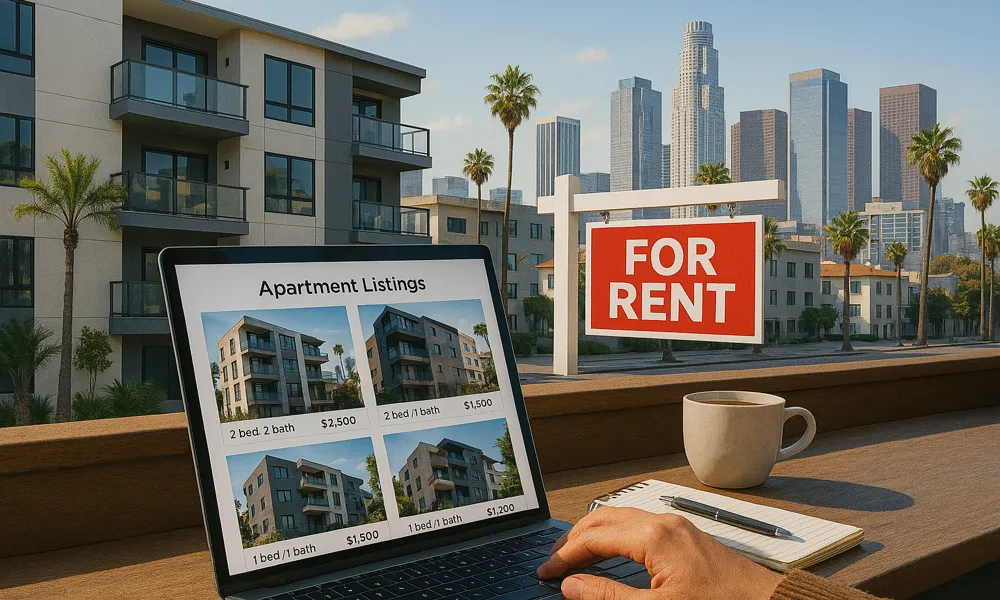Step-by-Step Guide to Finding Apartments in Los Angeles
Table of Contents
Planning to move to Los Angeles for college in 2025? You’re in for an adventure! With sunshine, palm trees, and over 60 universities—including big names like UCLA, USC, and Cal State LA—LA is a dream city for students from around the world. But before you start picturing beach weekends and late-night taco runs, there’s one big step you need to figure out first: Where are you going to live?
Finding an apartment in LA can feel a little overwhelming—especially if it’s your first time. From high rents and busy neighborhoods to lease agreements and roommate decisions, there’s a lot to think about. But don’t worry! This blog breaks it all down for you in simple steps—so you can rent smart, save money, and settle into student life stress-free. Let’s get you closer to your new home in LA—one step at a time!
How Does the LA Rental Market Look in 2025?
If you’re planning to study in Los Angeles in 2025, you’re not alone. LA is home to more than 60 colleges and universities, including world-renowned institutions like UCLA, USC, and Cal State LA. With over 1.2 million college students spread across California—and a large share of them in LA—the demand for housing is high, and so are the stakes.
According to recent reports, Los Angeles is now ranked among the top 5 most expensive rental markets in the U.S., with student-heavy areas like Westwood, Koreatown, and Silver Lake seeing rental increases of 4–8% from the previous year. Following is the average monthly rent in Los Angeles:
| Apartment Type | Average Rent (Monthly) | Best Suited For |
| Studio Apartment | $1,600 – $1,900 | Solo students, remote learners |
| 1-Bedroom Apartment | $2,200 – $2,600 | Couples, students who prefer personal space |
| 2-Bedroom Apartment | $2,900 – $3,400 | Roommates, student friends splitting rent |
| 3-Bedroom Apartment | $3,800 – $4,300 | Groups of 3 or more |
| Shared Room in Student Housing | $850 – $1,300 | Budget-conscious or first-year students |
| Furnished Short-Term Units | $2,500+ | International students, exchange students, interns |
What Are the steps for Renting Your First Apartment in LA?
Renting your first apartment in Los Angeles might sound a little scary—especially with rising rents, unfamiliar lease terms, and tons of listings to scroll through. But don’t stress! If you follow a smart, step-by-step process, you’ll find your perfect student home in no time.
According to a 2025 housing trends survey, over 68% of students in LA live off-campus, and about 40% rent with roommates to cut down costs. That means you’re not alone in this journey—and there’s a reliable process that most students follow to secure housing successfully. Below is the step-by-step checklist for first-time renters in Los Angeles (2025):
- Set Your Budget: Spend no more than 30–35% of your monthly income, scholarship, or family support on rent. It will help you avoid financial stress and plan for groceries, utilities, and transport.
- Research Neighborhoods: Look into areas near your university with good transit access and a safe environment. Some of the student-favorite areas include Westwood (UCLA), Koreatown, Silver Lake and orth Hollywood.
- Start Your Search Early: Begin at least 60–90 days before your move-in date. Best apartments get booked quickly! Spring and summer are peak rental seasons—starting early gives you more (and cheaper) options.
- Use Trusted Platforms: Browse listings on platforms like University Living. These platforms can help you in booking premium student housing in Los Angeles. Here you can also use filters for price, furnished options, proximity to campus, and reviews.
- Visit or Book Virtual Tours: Always inspect the apartment before committing. Look for Wi-Fi signal, natural light, and clean interiors. Use video tours if you’re out of town. Ask about maintenance and safety features.
- Gather Your Documents: Keep these handy: ID/passport, university admission letter, bank statements, guarantor info. These are important as landlords want to know you’re reliable and financially capable.
- Review the Lease Carefully: Go through the rent amount, duration, rules, renewal policy, and late payment fees. Don’t rush—ask questions and clarify confusing terms before signing.
What Are the Best Neighborhoods in Los Angeles for Students?
In a sprawling city like Los Angeles, your neighborhood decides how long your commute is, how much you spend on rent, and what kind of lifestyle you enjoy. With over 1.2 million students in California and more than 400,000 students enrolled in LA-based institutions like UCLA, USC, Cal State LA, and Loyola Marymount, the rental market around these campuses is buzzing. But LA is huge—each neighborhood has its own personality, price tag, and perks. Following are the top student neighborhoods in Los Angeles 2025:
| Neighborhood | Nearby Universities | Avg. Rent (1-BR) |
| Westwood | UCLA | $2,500 |
| Koreatown | USC (15 mins via Metro Purple Line) | $1,800 |
| Silver Lake | LA City College, ArtCenter (nearby) | $2,100 |
| Downtown LA (DTLA) | USC, Cal State LA | $2,300 |
| North Hollywood (NoHo) | LA Valley College, accessible to UCLA | $1,700 |
| Echo Park | Occidental College, close to Silver Lake | $2,000 |
| Palms | Loyola Marymount, West LA College | $1,900 |
How Much Should You Budget for Rent and Utilities in LA?
Let’s be honest—living in Los Angeles isn’t exactly cheap. In fact, according to the California Budget & Policy Center (2025), Los Angeles is now the second most expensive city in the U.S. for renters, just after New York. For students, this means planning your budget is a must.
While rent will likely be your biggest monthly expense, you also need to account for utilities, internet, groceries, transport, and a little breathing room for social life or unexpected costs. Whether you’re living solo, with roommates, or in student housing, budgeting wisely can help you live comfortably and focus more on your studies than your wallet. Following is the estimated monthly student budget in Los Angeles 2025
| Expense Type | Estimated Monthly Cost |
| Rent (1-BR Apartment) | $2,200 – $2,600 |
| Shared Apartment (per person) | $1,100 – $1,500 |
| Utilities (Electric, Gas, Water) | $120 – $180 |
| Internet (Wi-Fi) | $50 – $70 |
| Groceries & Daily Essentials | $300 – $400 |
| Public Transport (Student TAP Pass) | $50 – $75 |
| Phone Plan | $40 – $60 |
| Entertainment, Subscriptions, etc. | $100 – $150 |
| Eating Out / Social Life | $50 – $100 |
| Total Monthly Estimate | $2,870 – $3,525 |
What Amenities Should Students Prioritize When Renting in LA?
Let’s face it—renting in Los Angeles can be expensive, so it’s important to know which apartment features are worth the price and which ones you can live without. In 2025, a survey found that 81% of students in LA say they are willing to pay slightly more for practical amenities like in-unit laundry, high-speed internet, and secure access. Meanwhile, only 35% cared about luxury extras like rooftop lounges or smart appliances. Following are the must-have vs. nice-to-have amenities for students in Los Angeles (2025):
| Essential Amenities | Why You Need It | Luxury Amenities | Nice, But Not a Must |
| High-Speed Wi-Fi | For video lectures, online exams, group Zoom calls, and streaming study materials. | On-Site Gym | Great for staying healthy without paying for a separate gym membership. |
| Laundry Facilities (in-unit or on-site) | Saves time and energy, especially during exam weeks. | Rooftop Lounge / Deck | Fun for weekend hangouts, parties, or quiet evening breaks. |
| Secure Entry & CCTV | Extra peace of mind, especially if you come home late or live alone. | Balcony or Outdoor Space | A relaxing space to unwind or study with fresh air. |
| Proximity to Campus or Metro | Shortens your daily commute and saves on transport costs (especially with TAP pass). | Smart Appliances | Cool to have, but basic appliances work just fine for most student renters. |
| Heating & Air Conditioning | LA can get surprisingly cold in winter and hot in summer—comfort is key! | Furnished Units | Ideal for international or short-term students, but optional for long-term stays. |
| 24/7 Maintenance Support | Quick fixes for leaks, power outages, or broken appliances without extra stress. | Clubhouse / Common Room | Great for networking or hosting group projects, but not essential. |
Conclusion
And that’s your complete guide to finding the perfect student apartment in Los Angeles in 2025! From understanding how the rental market works to picking the right neighborhood, setting a realistic budget, and knowing which amenities are worth it—you’re now equipped to navigate LA’s housing scene with confidence.
Remember, the earlier you start your search, the better your chances of finding a place that suits your needs and budget. Use trusted platforms, ask lots of questions, and never settle for a place that doesn’t feel right. LA has something for everyone—and your ideal student apartment is out there waiting for you.
Frequently Asked Questions
What is the average rent for students in Los Angeles in 2025?
As of 2025, the average rent for a 1-bedroom apartment in LA ranges from $2,200 to $2,600/month. If you share a 2- or 3-bedroom unit, your share could be between $1,100 and $1,500/month.
What are the best neighborhoods in Los Angeles for students to live in?
Popular student neighborhoods include:
Westwood (near UCLA)
Koreatown (affordable and lively)
Silver Lake (creative, calm vibe)
Downtown LA (close to USC and internships)
North Hollywood (budget-friendly with Metro access)
When should I start looking for student housing in Los Angeles?
Ideally, 60–90 days before your move-in date. Apartments near colleges fill up quickly, especially between May and August, so starting early gives you better options and lower prices.
How much should I budget monthly as a student living in LA?
Here’s a rough monthly breakdown for student living in LA 2025:
Rent: $1,100–$2,600 (depending on shared or private)
Utilities & Internet: $170–$250
Groceries & Essentials: $300–$400
Transport (TAP Pass): $50–$75
Total Estimate: $2,870 to $3,525/month
What documents do I need to rent an apartment in LA as a student?
You’ll usually need:
Government-issued ID or passport
University admission letter
Proof of income or bank statements
Guarantor or co-signer details (if applicable)
Security deposit and completed rental application






